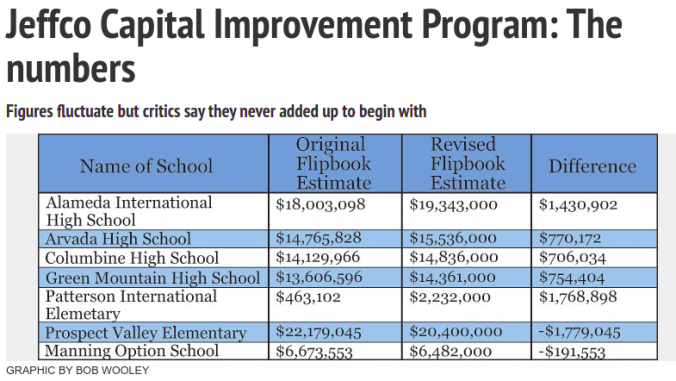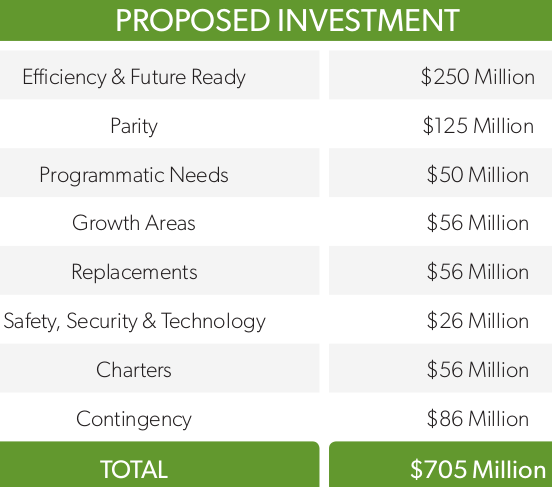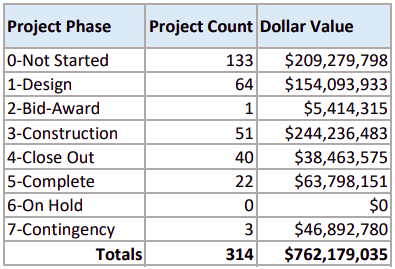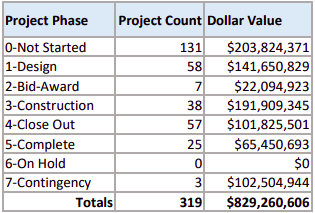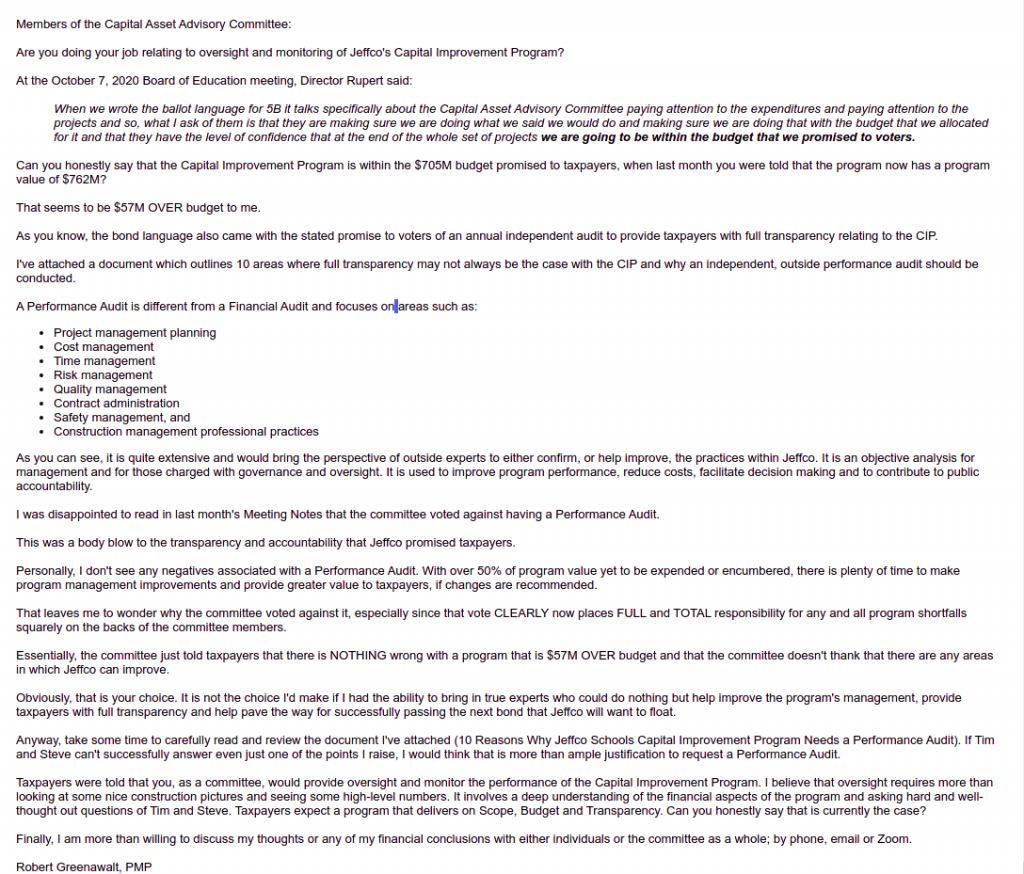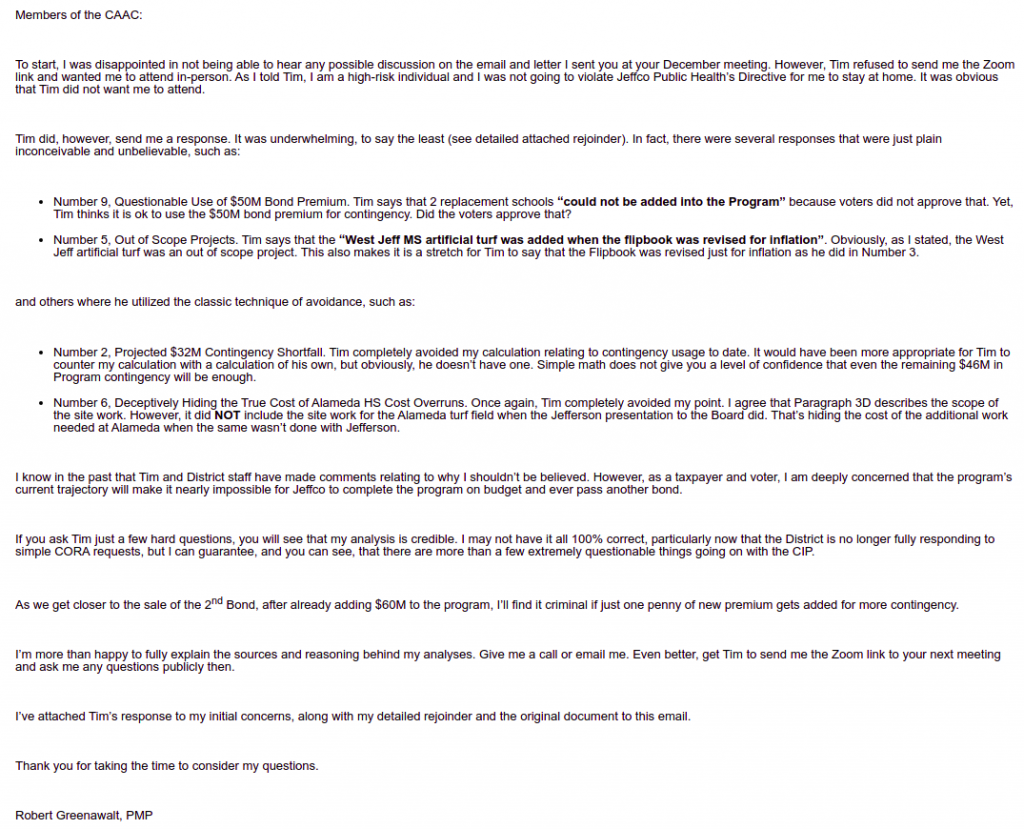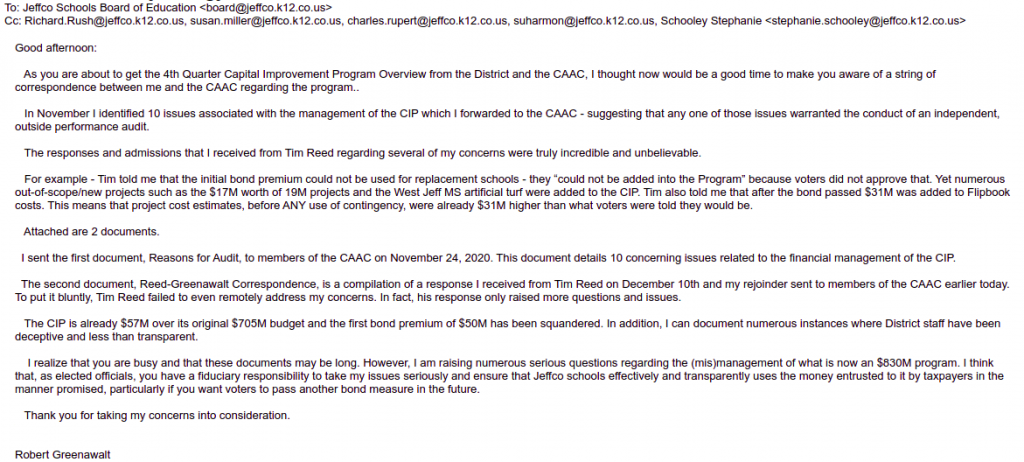Recently, Colorado Community Media, including Jeffco Transcript and Arvada Free Press printed an article by writer Bob Wooley about Jeffco’s Capital Improvement Program.
For the most part, Wooley did a good job of attempting to explain a financially complex program. However, there were some comments and statements made by Jefferson Public Schools’ officials that were misleading or downright false.
I’ve outlined several of those areas below:
1. The article states:
After the Bond passed, the project’s estimated costs were increased by nearly $32 million for a revised total of just under $737 million for the program.
TRUE – $32M in hidden costs were added to the program
After the bond passed, $32M in costs were added to the flipbook for the same list of projects. The use of $32M in contingency to cover these costs was essentially hidden.
2. The article states:
District officials say the increase was a result of changes in scope, market conditions, incorrect estimates or various other factors like asbestos removal, which were determined once the District was able to perform more in-depth evaluations of each individual project.
PARTIALLY TRUE – 81 schools’ cost estimates increased by EXACTLY 5%
While I agree that factors such as scope changes, market conditions and incorrect estimates can result in changed estimates, that doesn’t fully explain the extent of the cost estimate changes between the first and second flipbooks. The project costs for 81 schools, or nearly 60% of the total, increased by EXACTLY 5%. This is not indicative of changes in scope or incorrect estimates. That’s indicative of using Excel to pad costs.
3. The article states:
“We told voters we would accumulate six years of approximately $20 million at the back-end to fill up the program,” Reed says.
FALSE – Voters were told $23M
Voters were told that exactly $23M annually in Capital Transfer would be accumulated. In reality only $20.9M annually is currently being transferred. That means there is a $12.6M shortfall in stated revenue, again made up with Contingency.
4. The article states:
“and over $3.5 million was spent on hazmat expenses (which technically, do not count as overages).”
FALSE – Hazmat costs ARE overages
- Why aren’t $3.5M in hazmat expenses considered overages? Any decent construction project manager with 50 year old buildings knows there is asbestos in those buildings that will have to be mitigated. Mitigation costs should have been factored into the original estimates.
- Where is the money coming from to pay for the hazmat expenses? It’s coming from the District’s program contingency. Therefore, technically, and for all intents and purposes, hazmat expenses are program costs that reduce available contingency This is merely an attempt by Reed to put lipstick on a pig to make $3.5M in overages not seem like the $3.5M in overages hazmat costs really are.
5. The article states:
In a document Reed says is now posted to the Capital Asset Advisory Committee (CAAC) website, all budget variances are listed with specific overage amounts and the reason for the cost variance.
FALSE – This document lists variances against revised cost estimates, not original estimates
This document hides $32M in cost increases. That’s deception.
6. The article states:
Therefore, the precise amount of contingency that’s been spent on actual projects thus far is $65,815,424.
FALSE – The amount of contingency allocated is currently over $110M
$65M from what Reed wants people to believe is the contingency spent, plus $3.5M in hazmat, plus $32M in increased estimates plus $9M from recent fields project = $110M in contingency allocated.
7. The article states:
“I’m not a construction guy,” Bell said. “But we have a construction guy and I was speaking to him this morning and he said “you know, a year ago the cost of steel was $53 a ton — today it’s $79.” A year ago did anybody know it was going to go from $53 to $79? No.”
MISLEADING – Cost of steel is only one small component of cost increases
Both Tim and Steve have told the Board on several occasions that they have been getting good pricing due to the pandemic. And, this report shows that non-residential construction costs have been relatively flat in Denver for the last 2 years, increasing by only 2.1% total over that time. In addition, there are numerous projects that had no steel involved that are significantly over budget. This is a misleading and deceptive statement.
8. The article states:
“According to Tim Reed, Jeffco’s Executive Director Facilities & Construction, the amount of contingency that had been spent as of Feb. 22, was just over $81 million, of which nearly $12 million went to charter schools…”
MISLEADING to FALSE – $12M to Charters came from Bond Premium
The agreement with District Charters was that Jeffco would share approximately 10% of all bond proceeds with Charter schools. The $12M Tim Reed is referring to is based on Charters’ share of accrued interest and bond premium. This has nothing to do with District contingency.
The bottom line is that the Capital Improvement Program has already spent or allocated $24M over its original $86M contingency budget ($110M total) only 2.5 years into the program. In addition, Jeffco has hidden a $12M revenue shortfall from Capital Transfer. The amount of deception and lack of accountability for large cost increases is truly unbelievable.
